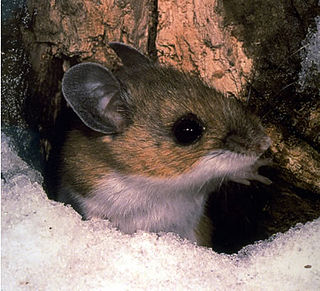
The Muroidea are a large superfamily of rodents, including mice, rats, voles, hamsters, lemmings, gerbils, and many other relatives. Although the Muroidea originated in Eurasia, they occupy a vast variety of habitats on every continent except Antarctica. Some authorities have placed all members of this group into a single family, Muridae, due to difficulties in determining how the subfamilies are related to one another. Many of the families within the Muroidea superfamily have more variations between the families than between the different clades. A possible explanation for the variations in rodents is because of the location of these rodents; these changes could have been due to radiation or the overall environment they migrated to or originated in. The following taxonomy is based on recent well-supported molecular phylogenies.

The Cricetidae are a family of rodents in the large and complex superfamily Muroidea. It includes true hamsters, voles, lemmings, muskrats, and New World rats and mice. At almost 608 species, it is the second-largest family of mammals, and has members throughout the Americas, Europe and Asia.

The Eumuroida are a clade defined in 2004 by Steppan et al. that includes rats, mice and related species, though not all rodents; in other words, a specific group of muroid rodents. The clade is not defined in the standard taxonomic hierarchy, but it is between superfamily and family.

The Old World rats and mice, part of the subfamily Murinae in the family Muridae, comprise at least 519 species. Members of this subfamily are called murines. In terms of species richness, this subfamily is larger than all mammal families except the Cricetidae and Muridae, and is larger than all mammal orders except the bats and the remainder of the rodents.

The rodent subfamily Sigmodontinae includes New World rats and mice, with at least 376 species. Many authorities include the Neotominae and Tylomyinae as part of a larger definition of Sigmodontinae. When those genera are included, the species count numbers at least 508. Their distribution includes much of the New World, but the genera are predominantly South American, such as brucies. They invaded South America from Central America as part of the Great American Interchange near the end of the Miocene, about 5 million years ago. Sigmodontines proceeded to diversify explosively in the formerly isolated continent. They inhabit many of the same ecological niches that the Murinae occupy in the Old World.

The New World rats and mice are a group of related rodents found in North and South America. They are extremely diverse in appearance and ecology, ranging in from the tiny Baiomys to the large Kunsia. They represent one of the few examples of muroid rodents in North America, and the only example of muroid rodents to have made it into South America.

The Neotominae are a subfamily of the family Cricetidae. They consist of four tribes, 16 genera, and many species of New World rats and mice, predominantly found in North America. Among them are the well-known deer mice, white-footed mice, packrats, and grasshopper mice.

Nyctomyini is a tribe of New World rats and mice in the subfamily Tylomyinae which includes two genera, Nyctomys and Otonyctomys, each with a single species. Both are medium-sized rats with tawny to brownish fur and a hairy tail.

The big-eared climbing rat is a species of rodent in the family Cricetidae. It is found in Central America from Mexico to Costa Rica.

Tylomyini is a tribe of New World rats and mice in the subfamily Tylomyinae. The rats share the characteristics of all being climbing rats.

In rodent anatomy, the zygomatic plate is a bony plate derived from the flattened front part of the zygomatic arch (cheekbone). At the back, it connects to the front (maxillary) root of the zygomatic arch, and at the top it is connected to the rest of the skull via the antorbital bridge. It is part of the maxillary bone, or upper jaw, which also contains the upper cheekteeth. Primitively, rodents have a nearly horizontal zygomatic plate. In association with specializations in zygomasseteric system, several distinct morphologies have developed across the order.









